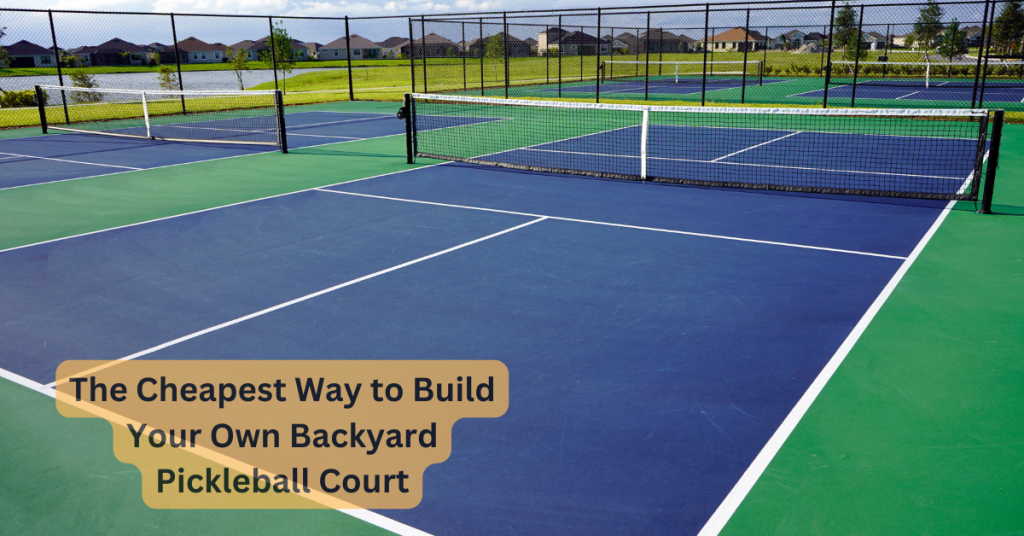
You’ve caught the pickleball bug and now you’re ready to build your own backyard court. But before you start swinging that hammer, it’s important to understand the full cost. Building a regulation-size pickleball court is no small investment, with expenses ranging from a few hundred dollars for a basic DIY project to tens of thousands for a pro-built court. In this post, I’ll go over the key factors that determine the full cost to build a pickleball court, provide a price estimate breakdown, and give you tips for keeping costs down. You’ll learn the cheapest way to build a pickleball court so you can start enjoying hours of dinking, volleying and smashing without breaking the bank. Whether you opt for concrete, asphalt or a modular tile court, I’ll make sure you have all the info you need to build your dream pickleball oasis on a budget. Let’s dive in.
DIY Backyard Pickleball Court
The most affordable way to build a backyard pickleball court is to do it yourself using basic materials. Here are some popular DIY court options:
- Asphalt or concrete pickleball court cost – Using an asphalt or concrete patio surface as a makeshift court costs $500-$2000. You’ll need a smooth, crack-free area of at least 20×44 feet. Paint pickleball lines and mount the net.
- Sport court tiles – Interlocking outdoor tiles create a modular court for $1000-$2000. Make sure to choose UV and weather resistant tiles. Level the ground before installation.
- Plywood – For $200-$500, you can build a plywood court. Use marine-grade plywood sheets to create a smooth play surface and paint pickleball lines. Elevate on cinder blocks to allow drainage.
Advanced Backyard Pickleball Surfaces
For a playing experience closer to professional pickleball courts, consider these enhanced backyard surfaces, you can also take help from pickleball court construction companies:
- SportGame court – Prefabricated courts specifically for pickleball run $5000-$8000 installed. Popular options are Nova ProBounce and SportCourt tiles.
- Asphalt or concrete resurfacing – Resurfacing an existing slab with an acrylic sports court finish costs $3000-$5000. Provides even bounce and playability.
- Post-tension concrete – Professionally installed concrete with embedded tension cables offers consistent ball response for $8000-$15,000.
Key Considerations for Your Backyard Court
Keep these factors in mind when designing and building your own pickleball court:
- Court dimensions – Regulation size is 20×44 feet for singles and 20×60 feet for doubles. Plan for safety space around the court perimeter.
- Surface flatness – Any unevenness will affect ball bounce. Asphalt or concrete is ideal for flatness. Compact and level the ground before installing tiles.
- Durability – Choose weather resistant materials that can withstand outdoor play over time. Asphalt and sport tiles need resealing every 2-5 years.
- Drainage and orientation – Slope the court slightly for drainage. North-south orientation avoids sun glare in players’ eyes.
Cost to Build a Pickleball Court Calculator
Here are typical price ranges for different backyard court setups:
- Painted lines on existing concrete or asphalt: $50 – $500
- Acrylic coating on existing concrete: $1,500 – $3,000
- Concrete pickleball court cost with acrylic surfacing: $8,000 – $12,000
- Modular tile court kit installed: $3,000 – $6,000
- Professionally built post-tension concrete court: $15,000 – $30,000
As you can see, a regulation DIY court can be built for under $1,000 if you have a suitable existing surface. Hiring a pro to install a premium court with specialized surfaces will run you $15,000 or more.
Tips for Keeping Costs Down
Here are some smart ways to save on your backyard pickleball court build:
- Use an existing concrete or asphalt surface if possible. This avoids the high cost of pouring a new slab.
- Buy acrylic surfacing and line paint in bulk online to get discounts.
- Rent equipment for surface preparation instead of purchasing.
- Recruit friends to help with installation in exchange for court time.
- Start with a smaller court and expand later if needed.
- Research court tile brands for best value and warranty.
- Install modular tiles yourself following manufacturer instructions.
The Cheapest Pickleball Court Option
The cheapest way to build a regulation-size backyard pickleball court is to paint lines on an existing concrete or asphalt surface. This can cost as little as $50 for materials if you have a suitable patio or driveway to work with. Using quality exterior line paint, you can precisely mark the court boundary, centerline, service boxes and non-volley zone lines as per official dimensions. Add acrylic surfacing down the line to optimize ball bounce and reduce joint strain for a few hundred dollars more.
The exercise, competition and social connection of pickleball are well worth the investment. With smart planning and strategic choices, you can create a quality pickleball court and enjoy hours of playtime right at home.
In summary, building your own backyard pickleball court can be an affordable DIY project if you plan carefully. The cheapest way is to paint lines on a concrete or asphalt surface, which can cost as little as $50 for materials. Prefabricated modular tile court kits run $3,000-$6,000 for a regulation-size court, while having a contractor pour a concrete slab with acrylic surfacing will be $8,000-$12,000. The key is following official pickleball court dimensions of 20×44 feet for doubles play. With smart planning and strategic choices, you can create a quality pickleball court and enjoy hours of playtime right at home. The exercise, competition and social connection of pickleball are well worth the investment.
FAQS
What are the essential materials needed to construct a backyard Pickleball court?
The essential materials for a backyard Pickleball court typically include a hard surface such as concrete or asphalt, Pickleball court lines, and appropriate fencing for containment and safety.
How much space is required to build a standard-sized Pickleball court in my backyard?
A standard-sized Pickleball court typically requires a rectangular space of about 30 feet wide and 60 feet long.
Can I use alternative materials to reduce costs without compromising the quality of the court?
Yes, alternatives such as compacted gravel or synthetic turf can be used to reduce costs while maintaining the court’s quality and functionality.
Yes, the surface should be smooth, sufficiently leveled, and provide adequate traction to minimize slips and falls during gameplay.
What are some DIY tips for those looking to build a Pickleball court on a limited budget?
Some DIY tips include using cost-effective materials like compacted gravel for the base, repurposing existing materials, and opting for simpler fencing options to minimize expenses.
How can I ensure proper drainage for the court, especially in areas prone to heavy rainfall?
Ensuring proper grading and installing a drainage system such as French drains or gravel trenches can help effectively manage water runoff and prevent pooling on the court surface during heavy rainfall.
To ensure safety and compliance, consider factors such as fence height, cushioning materials around the court, and adequate lighting for evening play. Additionally, check local zoning regulations and obtain necessary permits before constructing the court.
Regular sweeping, cleaning, and repairing any cracks or damage are essential for maintaining the longevity of a budget-friendly backyard Pickleball court. Applying a fresh coat of sealant periodically can also help protect the court from wear and tear.
